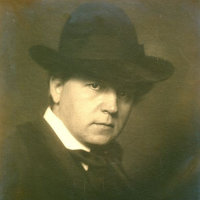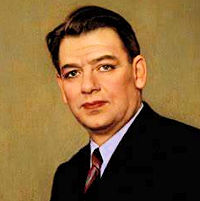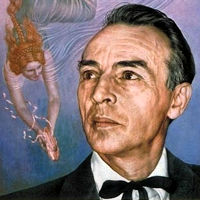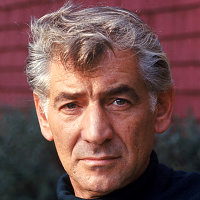| Handout (flat) Handout (folded) Class Script | Return to Index |
Q AND A
Why is the Carousel overture based on only one tune?
Unlike most Broadway shows at the time, Carousel began with an overture intended to be played with the curtain
up, while the carnival world is created before your eyes by action onstage. The Carousel Waltz was the obvious piece
to achieve that.
Isn't the whole point of ballet that it is not realistic?
Although there are several actual ballets that flirt with realism, dance as a whole is not a realstic medium. My point in
asking questions about reality was mainly in order to classify. Think of the three dance episodes that I played from
Oklahoma!. The barn-dance is realistic in that is develops from the kind of dancing that folks would do in a
real-life barn dance. "Kansas City" grows naturally out of characters and the situation, but breaks through into a different
medium for sheer entertainment. But the Dream Ballet is transcendent; it deals with imagination and emotion, not with
everyday reality at all; it can do this only because the ballet medium is intrinsically unrealistic.
Given this, how does the ballet work in Carousel?
Like the Ferenc Molnár play, Carousel challenges the audience with an unusually difficult situation: the protagonist
dead from suicide after being revealed as a wife-beater and a thief. This cannot easily be resolved by normal narrative
means; it requires transcendence. Molnár achieves this partly by allowing the lapse of 16 years, much as Shakespeare
did in his late plays such as The Winter's Tale. He also moves out of the everyday world by showing Billy in an imaginary
one, polishing the stars. Rodgers and Hammerstein have another form of transcendence available to them: ballet. I had hoped
to show that, by shifting to a less realistic medium, ballet bridges the gap. But I am not entirely convinced that it does; since
it deals only with new characters (Louise and the Starlight Carnival barker), it doesn't directly involve either Billy or
Julie, who are the couple who really need to reconcile. Which brings me on to the last question….
How does Carousel end?
The final scene that I played from the movie, when Billy speaks to Louise and then to Julie as they are singing
"You'll never walk alone, also occurs in the musical; you can see it in the Lincoln Center version here. I asked if this was enough to put the unresolved issues to rest; the tears in
many of your eyes said "yes"; I myself am not so sure.
Is it worth my while doing these Q&As?
I have written these question-and-answer updates after most classes so far, which is a lot of work, but nobody has mentioned
them. If you appreciate them, or even if you disagree with what I said, please let me know.
VIDEO LINKS
All the clips I showed in class were taken from the YouTube sources listed here. I have also included a good number of extras (all *asterisked). For Slaughter on Tenth Avenue, there is a dancer's commentary clip like the one I showed for Fancy Free. For Oklahoma, I show stage alternatives to all the movie scenes, plus some other things I found interesting. For Fancy Free, I have two other performances of the Second Sailor's solo and a documentary of how the ballet has changed over time. For On the Town, I have one blurry example of what I think is the original Robbins choreography, plus another version of the "Miss Turnstiles" dance (although this is neither Bernstein nor Robbins). The Liliom clip is taken from the complete movie, starting slightly earlier than in class.
For the Carousel scenes shown in class, I continue to juggle between the 1956 movie and the 2013 Lincoln Center concert; the links below also include the one I didn't play. Plus many additions: (a) some clips of the 1993 Nicholas Hytner production first seen in London, blurry but the only stage production available; (b) two stunning clips of Justin Peck's choreography from the 2018 Broadway revival; (c) a couple of standalone ballets derived from the show, but not intended to go into it; and (d) two commentaries, one informative, one provocative.
All the movie clips in fact lead to the complete film—but beware! Only Oklahoma! was supervised by its original creative team, and can thus be taken as an authentic translation of the Boadway show. The film of Carousel makes significant changes in narrative structure, plot details, and musical texture. And On the Town replaces most of the music and all the choreography, and was boycotted by its original creators. Both films of Slaughter on Tenth Avenue put the piece in a rather different context—but then Balanchine himself changed its entire mood when he remade it as a standalone ballet. rb.
| SLAUGHTER ON TENTH AVENUE | |||
| Original choreography | * 1939 film (with Vera Zorina) | ||
| Balanchine standalone version |
* Second pas-de-deux
(with commentary by Sarah Mearns) * Second pas-de-deux (Miami Ballet promo) |
||
| In Words and Music, (1949) | * Shorter version (same music, but much altered) | ||
| OKLAHOMA | |||
| Kansas City |
* Movie 1955, full number
(Gene Nelson as Will Parker) * London stage revival, 1998 (Jimmy Johnson as Will) |
||
| Barn Dance |
* Movie 1955, full number * London stage revival, 1998 (directed by Trevor Nunn) |
||
| Dream Ballet |
* Movie 1955, full number * London stage revival, 1998 (choreography by Susan Stroman) |
||
| Other scenes |
* "Many a new day," full number
(dance break in ballet style) * Jud's song, "Lonely room" (London 1998, a more sympathetic view) * Moral analysis of the show |
||
| FANCY FREE | |||
| The ballet as a whole |
* Complete
(1986 NYCB revival; rather blurry) * Jacob's Pillow documentary (compares original and modern revival) |
||
| Second Sailor's solo |
* Mikhail Baryshnikov
(grainy but good!) * Tiler Angle, with commentary (as shown in class) * Stéphane Bullion with Paris Opéra (the crispest of all) |
||
| ON THE TOWN | |||
| Opening scene | * Movie 1949 (Gene Kelly choreography) | ||
| Imaginary Coney Island | * Stage revival (blurry, but genuine Robbins) | ||
| Miss Turnstiles |
* Movie 1949, with Vera-Ellen
(Gene Kelly choreography) * Revival 2014, with Megan Fairchild (rehearsal with Joshua Bergasse) * Revival 2014, with Misty Copeland (stage performance of the above) |
||
| LILIOM | |||
| Complete film | * Cued to just before we started in class (Charles Farrell and Rose Hobart) | ||
| CAROUSEL, SCENES SHOWN IN CLASS (PLUS ALTERNATES) | |||
| Bench scene |
* Movie, 1955
(Shirley Jones, Gordon MacRae; with cuts) * Lincoln Center, 2013, with commentary (Kelli O'Hara, Nathan Gunn) * Commentary by Leonard Maslon (as quoted in the above) |
||
| Louise's ballet |
* Movie, 1955
(Susan Luckey, Jacques d'Amboise) * Lincoln Center, 2013 (Tiler Peck, Robert Fairchild) |
||
| Closing sequence |
* Movie, 1955
(equivalent of scene shown in class) * Lincoln Center, 2013 (Starts at very end of the sequence from class) |
||
| CAROUSEL, OTHER ITEMS | |||
| Nicholas Hytner, 1993 |
* Opening scene in London
(blurry, but only stage version available) * Press reels from Broadway version (shorter versions of many numbers) |
||
| Justin Peck, 2018 |
* Montage * "Blow high, blow low" (complete number, cut from the movie) |
||
| Standalone ballets |
* Sir Kenneth MacMillan
(Mayara Magri, Matthew Ball, Royal Ballet) * Chrisopher Wheeldon (excerpt, Pacific Northwest Ballet) |
||
| Commentary |
* Creation of the show
(documentary by Leonard Maslon) * Why Carousel went terribly wrong (critique of the film) |
||






















